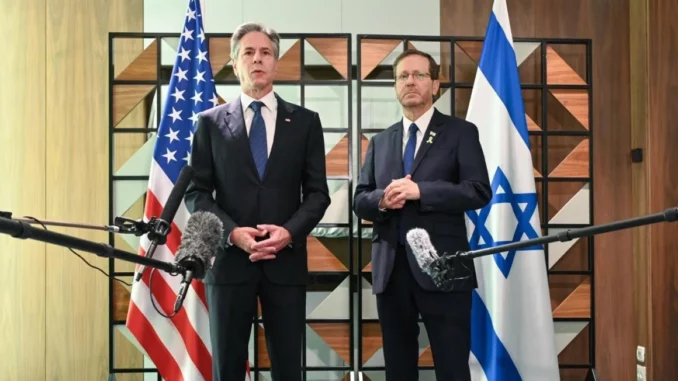
Following the failure of the Biden Plan, the ‘bridging proposal’ put forth by Antony Blinken is also on the verge of collapse in the wake of glaring mistrust between Hamas and Israel.

US Secretary of State Antony Blinken wrapped up his visit to Israel earlier this week, saying that he had consulted with Prime Minister Benjamin Netanyahu, who had accepted a ‘bridging proposal’ for a ceasefire in Gaza. He also called on Hamas to accept the ‘bridging proposal’. What is the Gaza ceasefire ‘bridging proposal’, and will it work in the troubled waters of the Israel-Hamas war? Can we expect the fighting to be ended in Gaza and peace to be established? In my estimation, a peace deal is still very elusive. Disagreements over Israel’s future military presence in Gaza are hindering progress on a ceasefire and hostage deal. Moreover, Netanyahu has repeatedly said that Israel will not stop the attacks until Hamas has been completely destroyed, and Hamas is unwilling to trust Israel for this reason. In this scenario, ending the conflict is not easy at all.
Blinken’s recent visit to Israel was an attempt to bridge the gaps. Clearly, he failed to secure a breakthrough for a Gaza cease-fire deal. More than ten and a half months have elapsed since the ongoing Hamas-Israel conflict started in Gaza. Many efforts have been made to end it but without success, for the conflict is showing no signs of ending. The underlying reason is that there is a big trust deficit between Hamas and Israel. It may be recalled that Hamas launched an attack on southern Israel on October 7, 2023, during which about 1,200 people were killed and 251 others were taken hostage. The Israeli military launched a counter-offensive in Gaza in which at least 40,334 Palestinians have been killed and 93,956 wounded. The vast majority of Gaza’s population has been displaced. A humanitarian crisis of unspeakable dimensions has resulted, and the life of the Palestinians in Gaza has become worse than hell. Ending this conflict is proving to be a huge challenge. Ageing gratefully Mediators from Qatar, Egypt and the USA spent months pursuing a three-phase plan in which Hamas would release the hostages in exchange for a lasting cease-fire, the withdrawal of Israeli forces from Gaza and the release of Palestinians imprisoned by Israel. The three-phase Israel–Hamas war ceasefire proposal was announced by Egypt and Qatar on May 5, and endorsed by Hamas on May 6. US President Joe Biden presented the deal and it came to be known as the Biden Plan.
This was the plan’s outline: PHASE I • A complete ceasefire • Withdrawal of Israeli forces from populated areas in Gaza • Release of some hostages and some remains of hostages Also Read – Nexus of Good: Groundwork for excellence • Palestinian civilians can return to their homes in Gaza • A surge in humanitarian aid .
PHASE 2 • A permanent end to hostilities • Exchange for the release of remaining living hostages • Israeli forces withdraw from Gaza
PHASE 3 • A major reconstruction plan for Gaza • The final remains of hostages are returned to their families.
On June 10, the United Nations Security Council supported the proposal as Resolution 2735. Hamas leaders largely accepted the announced “Biden plan” and the UN Resolution with some caveats. For example, they insisted that the end of the ceasefire as described in both be “permanent,” and that there be a complete withdrawal of all Israeli forces from Gaza. However, Israeli Prime Minister Netanyahu put a spanner in the works and ruled out a permanent ceasefire. He stated that Israel was open only to a partial ceasefire that did not include ending the war in Gaza. In fact, Netanyahu went further and rejected Biden’s proposal. He said in a social media post that the “actual” plan to which he agreed stipulated no end to the conflict until Hamas had been eliminated, no permanent ceasefire until all hostages were freed and victory was achieved and no end to an Israeli security role in Gaza.
The Gaza ceasefire mediators have been making a fresh bid to ‘narrow the gaps’ between Israel and Hamas. Two key sticking points concern Israel’s demands which it is unrelenting. These relate to the Philadelphi Corridor and the Netzarim Corridor respectively. Firstly, Israel insists that it must have full control over the Philadelphi corridor which is a 14-kilometre-long narrow strip of land running inside Gaza along its southern border with Egypt. Israel says that Hamas has been smuggling arms across this border. Secondly, Israel is adamant that displaced people returning from southern Gaza to northern Gaza be screened at the Israeli-controlled Netzarim corridor that effectively divides the territory of Gaza into two parts. This corridor will allow the Israeli army to bisect and control the Gaza Strip. Israel considers this corridor to be essential for carrying out raids in northern and central Gaza. In other words, these demands by Israel mean that it will continue to maintain its troops inside Gaza even after a peace deal is reached. Hamas has rejected any such presence, saying it contravenes a three-stage peace plan announced by Joe Biden at the end of May, and later endorsed by the UN Security Council, which ultimately envisages a complete Israeli withdrawal from Gaza. Hamas also says that Israel had changed its conditions and parameters at the last minute. Hamas also argues that any concessions it makes would be met by more demands by Israel. On the other hand, the Israeli Prime Minister’s office denied making ‘new demands’, asserting that their position was always well known to the Americans. So, either Netanyahu is pulling a fast one, or else the Americans did not convey the correct picture regarding the Israeli position to their fellow mediators from Qatar and Egypt.
Naturally, the disagreement over Israel’s future military presence in Gaza is also hindering progress on a ceasefire and hostage deal. The discussions around the Philadelphi corridor and the Netzarim corridor are proving to be contentious. Netanyahu is not budging from his position and neither are the Hamas leaders. Blinken’s recent visit to Israel was an attempt to ‘bridge the gaps’. Even more significantly, Israel has made it clear that a break in the fighting is all that it will agree to — not a permanent ceasefire. Netanyahu has made it clear that he is ready for a six-week ceasefire which will help to bring back some of the hostages while facilitating humanitarian relief supplies to reach the Palestinians in Gaza, but he would not give up on continuing the war in Gaza in order to destroy Hamas. In this scenario, even if an agreement is reached – still far from certain – it could end up lasting only weeks before it collapses and the war in Gaza resumes. Thus, Blinken’s ‘bridging proposal’ seems to be promising more than it can achieve.
Meanwhile, concerns grow about the possible expansion and escalation of the conflict. Hezbollah launched hundreds of rockets and drones at Israel early Sunday (August 25) as Israel’s military said it struck Lebanon with around 100 jets to thwart a larger attack, in one of the biggest clashes in more than 10 months of border warfare. Any major spillover in the fighting risks transforming into a regional conflagration drawing in Hezbollah’s backer Iran and Israel’s main ally the United States. This would be a truly frightening scenario!
(The writer is a retired Indian diplomat and had previously served as Consul General in New York)
(First published in the Millennium Post. https://www.millenniumpost.in/opinion/bridging-over-troubled-waters-577147)




Be the first to comment